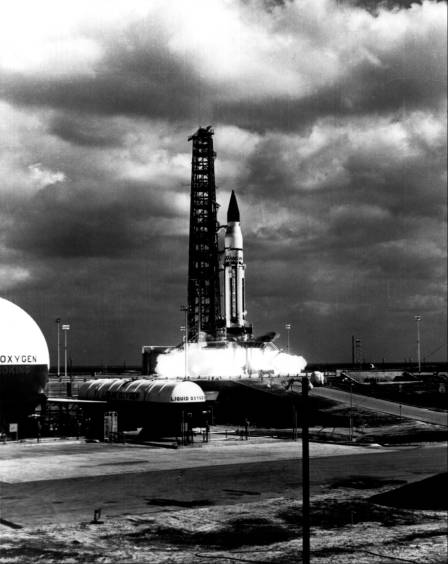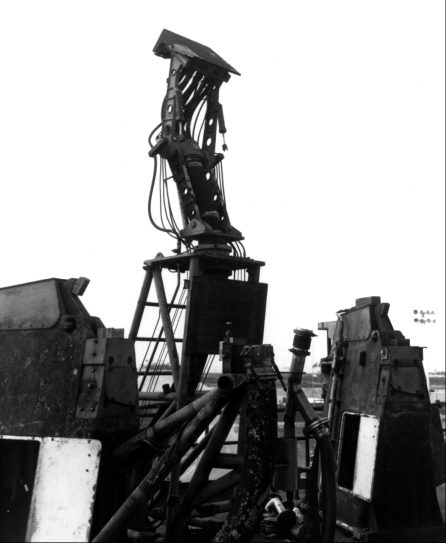
All's Well That Ends Well
The last weekend in January, America's television networks prepared live coverage of the SA-5 shot scheduled for Monday the 27th. An incident on Friday had threatened to postpone the launch: during a static firing test at Sacramento an S-IV stage had exploded, damaging the test stand and support equipment. After evaluating the accident, NASA officials decided the likelihood of an S-IV engine failure was sufficiently low to proceed with the SA-5 launch.34
Col. Lee James, Marshall's Saturn I-IB project manager, and Ted Smith, Douglas director of S-IV stage development, were among the 200 who gathered at the LC-37 blockhouse on Sunday evening for the start of the SA-5 countdown. Robert Moser was test supervisor for the operation; KSC's John Twigg and Douglas's John Churchwell served as test conductors for the S-I and S-IV stages. There were three holds during the night: 3 minutes for network checks, a 17-minute hold for battery verification, and a 27-minute hold to change an accelerometer. Shortly after sunrise the launch team discovered a leak in the S-IV main LOX line that took 48 minutes to correct.35
The countdown proceeded satisfactorily despite these minor problems. S-1 LOX loading began about 8:30 a.m. and went smoothly through the fast fill. When LOX reached the 93% level in the first stage tanks, the propellants team switched to the LOX replenish system (used to ensure a controlled slow flow). Instead of continuing its rise, the S-1 stage "mass readout" (the percentage of LOX in the tanks) began to fall. Launch officials quickly realized that the replenish system was not supplying LOX to the S-1 stage. Leroy Sherrer, Oxidizer Section chief, first thought a frozen valve might be the cause of the failure. Finding the replenish facility in order, Sherrer's group moved up the LOX line toward the pad. W. C. Rainwater's Ground Support Equipment Section started from the other end of the line, the base of the rocket. In less than an hour, the teams found the blockage - a "blind", flange (plate without an opening) left in the replenish line from a previous pressurization test. Safety precautions and venting problems precluded the immediate removal of the aluminum plate, and Debus reluctantly scrubbed the mission.36
A tired Rocco Petrone informed 150 newsmen of the launch postponement. He admitted that failure to remove the flange was a human error, but refused to single out anyone. "It was a routine procedure that we've done many times before. This time we didn't do it. We make mistakes."37 Debus had an even less pleasant task - explaining the mishap to five members of the House Subcommittee on Manned Space Flight, down from Washington for an inspection. The KSC director assured the visiting Congressmen that in future operations the launch team would tag flanges with red flags, as they presently did with all electrical work. In this way any deviation from the operational flight configuration would be flagged and a record kept by test supervisors. Debus rescheduled the launch for Wednesday morning, the 29th.38

The launch of SA-5, 29 January 1964.

The launch of SA-5, moments later.
There was one unplanned interruption in the second countdown, a 73-minute hold due to RF interference on the C-band radar and command destruct frequencies. At 11:25 a.m. SA-5 lifted off into a 37-kilometer-per-hour wind and a heavy sprinkling of clouds. Painted designs on the rocket's skin aided nine unmanned and four manned cameras to track pitch, yaw, and roll movements for the first l,000 meters. Six camera-equipped tracking telescopes, located along the Florida coast and on adjacent Grand Bahama Island, provided higher-altitude photographic coverage. Radars fed information to three computer-operated flight position plotting boards located in blockhouse 37. Another KSC computer, linked for the first time to an Eastern Test Range vehicle impact prediction computer, transmitted real time (very nearly instantaneous) vehicle position data to Marshall, as well as to Goddard Space Flight Center, NASA's communications center in Maryland. Telemetry aboard the SA-5 transmitted 1,183 separate measurements back to seven receiving stations in the Cape area; the ground stations relayed this information by radio and hardwire* to data processing machines in hangar D.39
The launch vehicle carried eight movie cameras and a television system to record stage separation and ignition of the S-IV engines. The separation of the two stages began at T+147.2 seconds, 6 seconds after the first stage inboard engine had shut down and 0.2 second after the outboard engines had cut off. The first action was the firing of small S-IV ullage rockets which forced propellants toward the engines. As booster retrorockets fired to slow the S-1 stage, explosive bolts disconnected the two stages. The S-1 and eight camera capsules fell into the Atlantic 800 kilometers downrange from Cape Canaveral. The S-IV engines then burned for 8 minutes, placing 16,965 kilograms in orbit, the heaviest payload in history.40
A nationwide audience viewed the SA-5 launch on television and received a remarkably clear booster engine shutdown at 60,000 meters altitude. Immediately following the launch, President Johnson telephoned his congratulations to the launch team in blockhouse 37. He told Wernher von Braun that he hoped his recent gift of a Texas hat would still fit the MSFC director. Von Braun contrasted the day's success with the Explorer I launch six years earlier and praised the Douglas Company for its role in developing the S-IV stage. Although the achievement of earth orbit was not even a secondary goal, Robert Seamans said the mission left "no question" that the United States had surpassed the Soviet Union in "ability to take large payloads into orbit." George Mueller, NASA's Associate Director for Manned Space Flight, described the launch as "the first step to the moon."41

Damage to pad 37B from the launchof SA-5. The short cable mast (top) carried electrical and pneumatic lines to the first stage. Access plates have ben opened in the support arms (lower R and L) to inspect the pneumatic system.
* Hardwire meant any system of electrical wiring over which signals passed, as distinguished from radio transmission.
| Next |